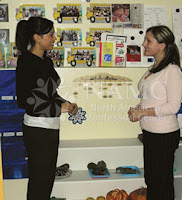 Part 3 of 3 - Parent Involvement
Part 3 of 3 - Parent Involvement In the first two parts of this series, I explained the value of the phase-in process for both the children and the teacher. Montessori preschool students gradually process the new and exciting ways of the Montessori approach to a school experience. They learn the grace and courtesy lessons at a pace that prevents them from feeling overwhelmed by too long of classroom time or too many other children. The Montessori teacher focuses on the procedures needed to support each child’s entry into the program. The smaller class size facilitates the teacher in becoming acquainted with each new student in order to guide the new child appropriately as class times grow in length and the needs of a large group change the Montessori classroom dynamics.
Often the parents’ first orientation/observation of a Montessori classroom takes place in the spring when the class is established, and they are considering placing their children in a Montessori program for the coming school year.
Parent Involvement is Key To Welcoming New Montessori Students - Some Tips
At that time students are generally close to normalization, the goal that is worked toward all year, when the children are working peacefully and purposefully after several months of being in the classroom. New Montessori parents may not realize that one of the key aspects of reaching that goal is the preparation done at the beginning of the school year. Phasing-in as an orientation tool is one critical technique in setting the tone for the rest of the school year.It is imperative that parents be informed of the school's phase-in policy at the point of enrollment because the phase-in period involves a graduated attendance schedule that is different from the regular school day that evolves once the student orientation is complete. This process can require special childcare arrangements to accommodate the child's limited and changing school attendance schedule. Also critical to parent phase-in communication is an explanation of why a phase-in approach is so important for their child. Until parents begin to understand why the larger class sizes of a Montessori environment work to the benefit to all the children, they need to know that the Montessori teacher is utilizing a technique that helps the new child transition into such a classroom.
When parents first inquire about the school, I always include in my parent information/enrollment package a detailed explanation of how we structure phase-in orientation. About a month before school starts, I send the parents the schedule of when their child will start school and at what times. Sometimes, I may have an older sibling already in the classroom, and I make adjustments to help out those parents. At our parent orientation meetings in the week before school begins, the phase-in process is again discussed. Any questions that arise are addressed to reassure parents that their child's best interests are being served through the phase-in orientation process.
Related NAMC Blogs:
- Orientation of New Students at Start of School- Montessori Phase In
- Orientation of New Students at Start of School - Montessori Summer Transition
- Montessori Leadership Guide: Building a Montessori Community
- Parent Education Beyond Orientation: Tips for Teachers - Montessori Community
As much as possible, NAMC’s web blog reflects the Montessori curriculum as provided in its teacher training programs. We realize and respect that Montessori schools are unique and may vary their schedules and offerings in accordance with the needs of their individual communities. We hope that our readers will find our articles useful and inspiring as a contribution to the global Montessori community.
© North American Montessori Center - originally posted in its entirety at Montessori Teacher Training on Friday, November 4, 2011.
© North American Montessori Center - originally posted in its entirety at Montessori Teacher Training on Friday, November 4, 2011.

0 comments:
Post a Comment
Have questions or comments? Let us know what you thought about this article!
We appreciate feedback and love to discuss with our readers further.